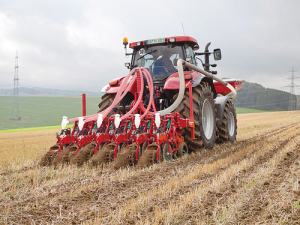Kverneland to debut Alentix fertiliser spreaders at Agritechnica
With Agritechnica just around the corner, it’s no surprise to see manufacturers drip-feed some information of new products worth a closer look.
 The introduction of the Kverneland KultiStrip System will “bring opportunities to farm environmentally and improve yields and profitability."
The introduction of the Kverneland KultiStrip System will “bring opportunities to farm environmentally and improve yields and profitability."
The introduction of the Kverneland KultiStrip System by distributor Power Farming will “bring opportunities to farm environmentally and improve yields and profitability,” the company says.
The system uses a one-pass cultivator-fertiliser machine which encompasses a strip-till system to reduce cultivation costs, aid plant establishment, improve soil condition and ensure yields.
Strip tillage is an innovative method of preparing the soil for crops planted in rows, such as maize, beet, sunflower, canola, sorghum, soya, vegetables and hybrid corn. This method has been used for at least 20 years in North America and is now getting traction in Europe and Australia as environmental awareness increases.
Given the pressure to improve the quality of New Zealand waterways, the Kultistrip should offer growers and contractors a tool to help limit erosion, particularly on sloping ground, which will keep regulators away from the farm.
In strip tillage, only the soil where the crop will grow is disturbed, leaving up to 70% of the paddock uncultivated, cutting tillage costs. The uncultivated soil between the strips, and the layer of residue that remains, help to prevent erosion while increasing water absorption and retention in the soil.
Within the cultivated row, trash is removed and a fine seedbed offers the best conditions for young plants to establish. When creating the seedbed, fertiliser can also be placed near the plants for best utilisation. With less of a paddock being cultivated, there is a possibility of completing work during poor weather, or even planting earlier in a season to help bring harvest dates forward.
Looking at the machine in more detail, the rigid 3000, 4500 and 6000 models have working widths of 3, 4.5 and 6m, respectively, and have a heavy-duty mainframe. Alternatively, the 4500F and 6000F models have hydraulically folding frames which bring the units down to 3m wide and 4m high to meet transport regulations.
Both rigid and folding designs of the Kultistrip can be fitted with an even or uneven number of rows, with a row width of 45-80cm. The 3m unit can be configured with up to six rows, the 4.5m up to 10 and the 6m up to 13 rows.
The system layout of the Kultistrip initially has 520mm cutting discs cutting through the crop residues and opening the soil to a pre-set depth, before adjustable trash wheels remove the plant residues from the cultivated strip.
Next, the tines work to a maximum depth of 30cm, with a choice of three options for differing soil types.
An adjustable strip-limitation disc determines the width and shape of the cultivated strip as well as keeping loose soil within the strip. Finally, a press wheel consolidates the soil using a rubber Farm Flex wheel or optional cage roller or V-press wheels for varying soil types.
Fertiliser is placed in the lower levels of the cultivated soil by the fertiliser coulter, as the soil is worked in one single pass. The cultivation tine and the fertiliser tube can be adjusted independently.
Alternatively, the Kultistrip machine can be used with an effluent tanker to place liquid manures in the soil at a pre-determined depth.
Product specialist John Chapman says “the Kultistrip system is multifunctional in that it allows operators to cultivate, deliver mineral or liquid fertilisers and drill in one pass.
Then by utilising a strip-till approach it can reduce establishment costs and help reduce the environmental impact of traditional crop establishment systems”.
One person intimately involved in the new legislation to replace the Resource Management Act (RMA) is the outgoing chief executive of the Ministry for the Environment, James Palmer, who's also worked in local government.
Horticulture New Zealand (HortNZ) says a new report projects strong export growth for New Zealand's horticulture sector highlights the industry's increasing contribution to the national economy.
Fonterra shareholders say they will be keeping an eye on their co-operative's performance after the sale of its consumer businesses.
T&G Global says its 2025 New Zealand apple season has delivered higher returns for growers, reflecting strong global consumer demand and pricing across its Envy and Jazz apple brands.
New Zealand's primary sector is set to reach a record $62 billion in food and fibre exports next year.
A new levying body, currently with the working title of NZWool, has been proposed to secure the future of New Zealand's strong wool sector.

OPINION: Federated Farmers has launched a new campaign, swapping ‘The Twelve Days of Christmas’ for ‘The Twelve Pests of Christmas’ to…
OPINION: It used to be that the National Fieldays attracted brickbats for being officious clipboard carriers, while the regional, farmer-run field…